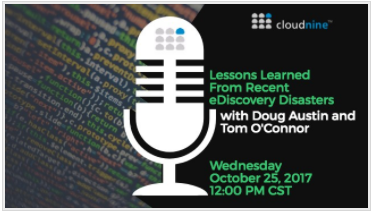Avoiding Glittering Generalities in Selecting eDiscovery Software – Considering Complexity: eDiscovery Best Practices
Editor’s Note: If you read our blog regularly, you know that we frequently reference my friend and CloudNine colleague Rob Robinson’s excellent blog, Complex Discovery for various industry information, including quarterly business confidence surveys, eDiscovery software and service market “mashups” and information about industry mergers and acquisitions (among other things). We’ve been discussing aspects of on-premise and off-premise eDiscovery offerings quite a bit lately (including this recent webcast conducted by Tom O’Connor and me a few weeks ago) and Rob has written a terrific article on the subject which he has graciously allowed me to publish here. This is the fourth part of his multi-part article (parts 1, 2 and 3 here, here and here) – we will publish it in a series over a couple of weeks or so. Enjoy! – Doug
Considering Complexity
“Simplicity does not precede complexity, but follows it.” Alan Perlis
The ability of eDiscovery software to deal with data complexity such as being able to ingest and process an increasing number of data formats is one of the most important challenges faced by eDiscovery professionals today. In fact, according to the Summer 2017 eDiscovery Business Confidence Survey, almost 22% of 101 eDiscovery ecosystem respondents highlighted that the challenge of increasing types of data would have the biggest impact on their business during the next six months.
In facing this challenge, many organizations have employed a combination of software offerings, integrated through workflow, to address both non-complex and complex data in their discovery efforts. One example of this combinatorial approach to solving this specific challenge is to employ an off-premise, SaaS-based offering using a private cloud approach based on emerging technology and then leveraging an on-premise, mature eDiscovery processing engine to address volume and file format challenges not able to be addressed by the off-premise platform. This combination approach takes advantage of the speed and cost benefits of the cloud to deal with a majority of eDiscovery volume and file format challenges and the robustness of a mature on-premise offering to address complexity challenges presented by high volumes of data and an increasing number of file formats. While many software providers highlight the fact that their specific offering can handle all eDiscovery challenges, their assertion may have limits. Those limits being that it may take much more time to complete high volume and non-mainstream file format related requests than with the prudent approach of a combination of on-premise and off-premise offerings offering a balance of emerging and technology.
Quick Takeaway: With the complexity of many eDiscovery challenges, a combination of software solutions may be required to accomplish certain complex task requirements satisfactorily. These combinations of solutions may include on-premise and off-premise offerings working in a complementary fashion. Given that most organizations will face a degree of complexity at some point that cannot be solved by a single eDiscovery solution, it seems reasonable to make offering selections that do not prevent efficient interoperability with other platforms.
Thursday, we will address the last area of evaluation, providing a consideration of cost.
So, what do you think? What factors do you consider when evaluating and selecting eDiscovery software? Please share any comments you might have or if you’d like to know more about a particular topic.
Also, I’m excited to report that eDiscovery Daily has been nominated to participate in The Expert Institute’s Best Legal Blog Contest in the Legal Tech category! Thanks to whoever nominated us! If you enjoy our blog, you can vote for it and help it win a spot in their Best Legal Blogs Hall of Fame. You can cast a vote for the blog here. Thanks!

Disclaimer: The views represented herein are exclusively the views of the author, and do not necessarily represent the views held by CloudNine. eDiscovery Daily is made available by CloudNine solely for educational purposes to provide general information about general eDiscovery principles and not to provide specific legal advice applicable to any particular circumstance. eDiscovery Daily should not be used as a substitute for competent legal advice from a lawyer you have retained and who has agreed to represent you.





